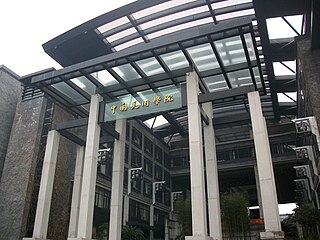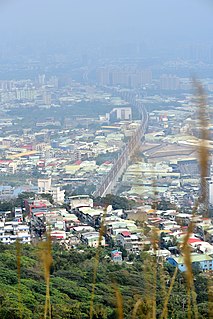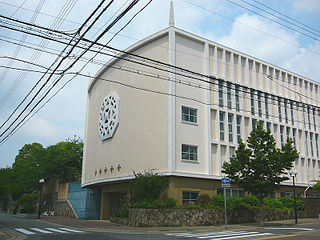
Hsinchu is a city in Taiwan. Hsinchu is the 7th largest city in Taiwan by population, with 446,701 inhabitants, and the largest not to be a special municipality. Hsinchu is a windy coastal city bordering the Taiwan Strait to the west, Hsinchu County to the north and east, and Miaoli County to the south.
The National Languages Committee was established in 1928 by the Ministry of Education of the Republic of China with the purpose of standardizing and popularizing the usage of Standard Chinese in the Republic of China. The Committee was known in English as the Mandarin Promotion Council or the National Languages Promotion Committee until 2003, but the Chinese name has not changed. The phrase Guoyu typically refers to Standard Chinese, but could also be interpreted as referring to "national languages". The reorganization of the Executive Yuan made the duties of the National Languages Committee be transferred to the Department of Lifelong Education's fourth sector from 2013.

China Academy of Art, also translated as China National Academy of Fine Arts, is a fine arts college under the direct charge of the Ministry of Culture of China. It was founded in Hangzhou in 1928 by the government of the Republic of China and the renowned educator Cai Yuanpei. It was the first art university and first graduate school in Chinese history. It is a Chinese Ministry of Education Double First Class Discipline University, with Double First Class status in certain disciplines.

Shulin District is an inner city district in southwestern New Taipei City, Taiwan.

Chiayi metropolitan area is the urban area surrounding the Chiayi City.

Jack C.K. Teng, was a Chinese educator, writer, politician, diplomat and Olympic pioneer. He is best known as the Chairman of the Chinese National Olympic Committee during the 1960 Summer Olympics, the first time a Chinese athlete won an Olympic medal.

Buke in the high schools of mainland China refers to the social phenomenon of extra study for the improvement of students’ academic performance in National Higher Education Entrance Examination in the form of extra mandatory classes organized by high schools or private tutoring provided by cram school.

National Dong Hwa University is a national research university located in Hualien, Taiwan. Established in 1994, NDHU is widely considered as a high potential research university and the most prestigious university in Eastern Taiwan by Liberty Times, THE, QS. The university offers a wide range of disciplines, including the sciences, engineering, computer science, environmental studies, law, arts, design, humanities, social sciences, education sciences, marine science, music, and business.
The New Taipei Municipal Sanzhi Junior High School is a junior high school in Sanzhi, New Taipei City, Taiwan.

The Yokohama Yamate Chinese School is a Chinese-style primary and junior high school in Naka-ku, Yokohama, Japan. Serving levels kindergarten through ninth grade, it is one of two Chinese schools in Japan oriented towards Mainland China, and one of five Chinese schools total. As of 2008 Pan Minsheng is the principal.

Kobe Chinese School is a Chinese international school in Chuo-ku, Kobe, Japan. It is one of two Mainland China-oriented schools in Japan, the other being Yokohama Yamate Chinese School. It provides elementary and junior high school education in grades 1-9 and offers first choice in admission to children of alumni. The second choice is priority to Chinese people. The school established a policy of trying to minimize enrollment of Japanese students in 2000. In 2008 about 40% of the students were Japanese nationals who are ethnic Chinese.

The Kaohsiung Japanese School is a Japanese international school on the campus of Kaohsiung Municipal Lingya District Jhong-Jheng Elementary School in Lingya District, Kaohsiung, Taiwan in the Republic of China.

Taichung Japanese School is a Japanese international school in Daya District, Taichung, Taiwan in the Republic of China.

Seoul Overseas Chinese High School or Hanseong Chinese Middle and High School is a Republic of China (Taiwan)-oriented Chinese international junior and senior high school in Seodaemun-gu, Seoul, South Korea. It follows the curriculum of the ROC, and accordingly uses textbooks from Taiwan.
Taiwanese Society of Child and Adolescent Psychiatry is a Taiwan-based union of child and adolescent psychiatrists founded in November 7, 1998 with the mission to promote the healthy development of children, adolescents, and families through advocacy, education, and research, and to assist members to meet the professional requirements of child and adolescent psychiatrists throughout their careers.

The Yunlin County Tuku Junior High School is a junior high school located in Tuku, Yunlin, Taiwan, which has two kinds of special classes - Chinese music class and PE class.
School district houses are houses within a school district in China that allow students free admission to the nearest school. Students who take advantage of school district houses can enter the nearest school without exams.

Wu Li-hua, known in the Rukai language as Saidhai Tahovecahe, is a Taiwanese Rukai educator and politician. She is the first member of the Democratic Progressive Party to sit in the Legislative Yuan as a representative of the Highland Aborigine Constituency, to which she was elected in 2020.

Chung Yuan Christian University Chang Ching Yu Memorial Library is the library at Chung Yuan Christian University in Zhongli District, Taoyuan City, Taiwan.
The Yeh Yung-chih incident was a campus incident involving sexual diversity issue in Taiwan. Yeh Yung-chih, a third-grade student of Gao-Shu Junior High School in Gaoshu Village, Gaoshu Township, Pingtung County, was bullied by some classmates because of his gender nonconformity. On April 20, 2000 at 11:42, Yeh left the classroom early to go to the bathroom. He was later found seriously injured and lying in a pool of his own blood. He later died at a local hospital. This incident incited a discussion about gender education in Taiwanese society, which led to the revision of the original "Gender Equality Education Act" to "Gender Equity Education Act" in 2004. The education policy was also altered from a traditional view of sex into a more universal gender equality education system.

















